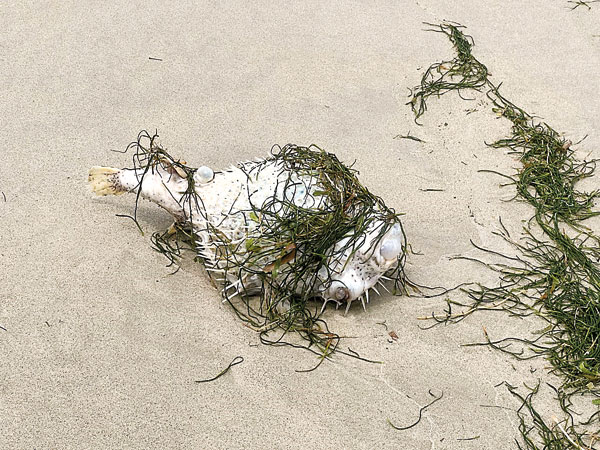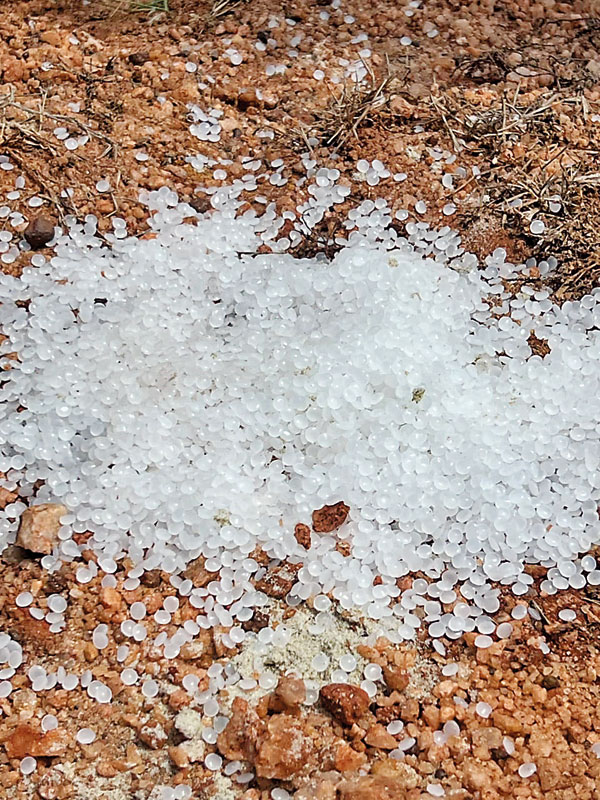News
Cargo ship disaster plastic pellet cleanup claims raised with insurer
View(s):By Tharushi Weerasinghe
Local authorities have begun insurance discussions to pay for cleanups of the plastic pellets along Sri Lankan shores from the shipwrecks off the coast of Kerala.
“We have begun Protection and Indemnity Club meetings with North Standard, the insurer, who has agreed to compensate us for the direct preventive and cleanup costs by way of incurred expense claims,” noted Jagath Gunasekara, general manager at the Marine Environment Protection Authority.

Environmentalists reported seeing dead puffer fish
A comprehensive shoreline survey is underway to assess the scale of plastic pellet contamination across Sri Lanka’s coasts.
Initial results point to medium to high levels of contamination in the Jaffna Peninsula, particularly in Nainativu, Delft, Uduththurai and smaller islands in the archipelago. Kilinochchi and Mannar have recorded longer stretches of affected coastline — up to 12 km in some areas. Other impacted locations include Puttalam, Kalpitiya and several sites along the northwestern coasts. Surveys have shown the lingering presence of plastic pellets from the MV X-Press Pearl incident in Negombo. Polluted patches have also been found at Galle Face, Wellawatte, Dehiwala, Mount Lavinia, Wadduwa and three to four sites around Galle. Surveys in the Colombo and Galle districts have already been completed.
Cleanup efforts have already begun with the support of the tri-forces. “This is a two-way approach,” Mr. Gunasekara said. “While the military is currently handling the cleanup, we will begin involving local communities starting next week.”
Pellets are removed with shovels. Additionally, scientific techniques such as size and density separation are also being used to isolate and collect smaller particles.
Cleanup in the north is proving more difficult due to natural debris and shifting shoreline conditions. “We’re using backpack vacuum blowers for rocky coastal areas,” he added, noting that these cleanups would likely need to continue for some time.
Parallel to the cleanup operations, MEPA is collaborating with several state agencies, including the Department of Wildlife, NARA, the Central Environmental Authority, the Department of Fisheries, and the Ministry of Tourism, to estimate environmental and economic damage. These evaluations, which will be used to support compensation claims, are expected to take up to six months. The Attorney General’s Department has been asked to advise on whether legal action for compensation should be pursued independently or jointly with the Indian authorities.

plastic pellets that have washed ashore
Calls to reform the Marine Pollution Prevention Act, which mandates responses to maritime disasters, have been longstanding, especially in the context of pursuing international claims. A cabinet paper requesting approval for a consolidated Act has been under discussion since 2019.
“But the incidents like X-Press Pearl caused overlaps in information that we had to resolve before proceeding, and the papers had to be redone,” Mr. Gunasekara noted. The new Act would allow Sri Lanka to incorporate nine international conventions that are pending cabinet approval.
Under general international law, particularly the FUND Convention, only restoration-related expenses are eligible for compensation, not full environmental damages. “We are expecting compensation for restoration, but international law does not cover everything,” Mr. Gunasekara clarified. “That’s why a stronger local legal instrument is essential.”
While the exact environmental impact remains under study, authorities say immediate risks to public health and marine life are low. “There is currently no proof that fish are swallowing the pellets,” Mr. Gunasekara said. “The concern is more about long-term chronic exposure — whether toxicity might transfer to fish flesh.” But he insisted that, scientifically, authorities claimed there is no evidence to justify a fishing ban at this stage.
“No biodiversity loss has been observed yet, but we will not know for sure until our studies are complete,” said Dr. K.H.M.L. Amaralal, deputy director general, NARA. However, environmentalists reported seeing dead puffer fish along the coasts in Mannar during their site visits.
Three specialist teams from NARA, focusing on social and economic impact, environmental damage, and bathymetric impact, have done field investigations for an initial report that will be completed within two weeks.
“The scientific studies become relevant for further claims based on damage, so we do have slightly more time to try and quantify what the damage is,” said Dr. Amaralal. He also added that resources and expertise gained during the X-press Pearl incident were helping the process.
Greenpeace South Asia has also begun its studies on potential harms from the pellets, following field visits to Mannar and Pamunugama, where “significant and increasing volumes of pellets” were appearing on the coastlines. “We have collected samples from Sri Lanka and Kerala to send to our science units in the UK to study the chemical composition and prepare for potential impacts.” The report is expected by the end of July.
“There are underlying systemic issues that also need to be addressed concurrently because disasters like this are almost irreversibly hard to recover ecosystems from,” said Anita Perea, ocean campaigner for Greenpeace South Asia.
The methods used to transport goods were one of the issues.
“Plastic pellet bags are fragile and break apart easily in the water, leading to the tiny particles just dispersing all over the sea where marine life cannot always discern between them and food.” Ms. Perera also said that this was especially concerning as pellets absorb other chemicals easily and can affect any beings that eat the fish, a concern in Mannar, which also hosts many migratory birds.
“The only way to clean up, is when it washes ashore, but harm to biodiversity is hard to quantify at that stage.” She insisted that prevention was better than cure, as pellets from the X-press Pearl were also still washing ashore in some parts of the island, based on findings by other conservation organisations.
Earlier this month, the Biodiversity Project team in the Western Province recorded about 137 plastic pellets (nurdles) within a 10×10 inch area, down to a depth of 20cm at Mount Lavinia — evidence, they say, of the persistent presence of pellets years after the initial spill.
In a follow-up survey on 14 June 2025, after new pellets began washing ashore from the MSC shipwreck, the team collected around 609 pellets within just 20 minutes along a 400m stretch of beach between Mount Lavinia and Dehiwala, indicating a minimal but steadily accumulating impact.
The best way to say that you found the home of your dreams is by finding it on Hitad.lk. We have listings for apartments for sale or rent in Sri Lanka, no matter what locale you're looking for! Whether you live in Colombo, Galle, Kandy, Matara, Jaffna and more - we've got them all!

